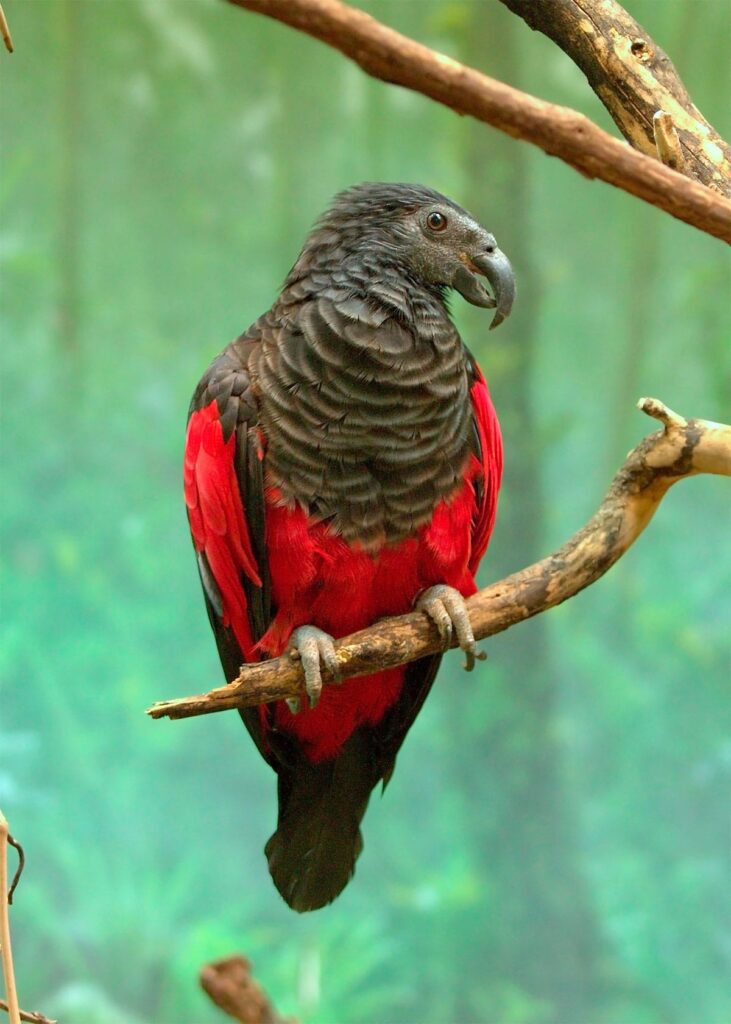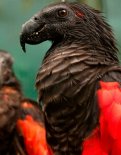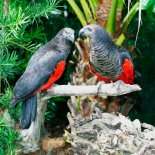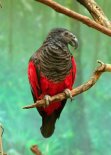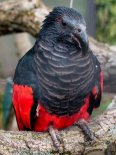Content |
|---|
Description
46 cm. length and a weight between 680 and 800 g..
The head of the Pesquet's Parrot (Psittrichas fulgidus) is black, front without feathers, may be covered with small ruffled black feathers with a patch of stiff red feathers on the front of the legs ear-coverts. Nape, the mantle, back and tail blackish brown with fine pale edges.
Uppertail Red with black bases. Upper, black flight feathers, with large and medium-sized external coverts (except the innermost) and vane external Central flight feathers, red; Black primary coverts. Under, Black tail with red in the lower and medium coverts. More Brown on the top breast than in the rest, with a wavy effect to pale fringes to the feathers; belly, flanks and coverts red infracaudales. Upper, the black tail.
black beak; black skin of the face; dark brown irises; Blackish grey legs.
The female It lacks the red patch on the side of the head and is slightly smaller on average.
In birds immature the red marks are more off.
- Sound of the Pesquet's Parrot.
Habitat:
The Pesquet's Parrot are found mainly in the primary and secondary montane rain forest at an altitude between 600 and 1.200 m. However there are to the 2.000 m, and are occasional at altitudes as low as 50 m.
The species is thought, generally, they have a low density of population, finding the highest concentrations in forest areas relatively calm, where the birds are free from persecution.
These large and showy parrots, They are commonly found in pairs or in groups of up to 20 individuals, perched, usually, at the top of the exposed trees, or loud flying through or above the canopy.
Jump nervously around the Bush with quick flapping, and they can stay in the tops of emergent trees during a rain. It has been flying to settle on a solitary tree in the midst of the darkness.
Reproduction:
Reproductive habits in nature are unknown, but birds in breeding conditions have been observed in the months of February to May. In captivity a pair was observed to courting; There was a two-egg-laying, which were incubated by the female during 31 days, and the only chick, yellowish white, was fed by both parents.
Food:
The Pesquet's Parrot mainly feed on the soft pulp of fruits such as Ficus figs, handles (Mangifera indica) and Freycinetia cumingiana.
During their feeding, the base of the beak can become covered with fruit pulp, and it is likely that extension of the exposed facial skin has evolved to avoid that feathers absorb from food scraps.
Distribution:
Size of the area of distribution (reproduction / resident): 278.000 km2
confined in West Papua New, Indonesian and Papua New Guinea. It goes from the Mountains Tamrau, Vogelkop, West Papua, to the East by the mountains of snow and Cordillera Central (including the upper part of the fly river, Lake Kutubu and Karimui district), on Owen Stanley mountain range and Huon Peninsula, in the East of Papua New Guinea.
The species is unevenly distributed in montane forests, and is considered uncommon in most areas. World population is thought to be in decline, mainly due to hunting for food and feathers (that are more appreciated even than the feathers of the bird of paradise Paradisaeidae).
The introduction of weapons has significantly increased the pressure of the species in more densely populated areas. Live bird trade and habitat loss, It is also thought that they represent potential threats. There are a small number in captivity.
Conservation:
• Current category of the Red List of the UICN: Vulnerable
• Population trend: Decreasing
It is estimated that their population may be setting to the 42,000 birds.
This species is under severe pressure from the hunt for obtaining their colorful feathers, and to one degree lower for trade and meat. Hunting for feathers has increased with population growth and the increasing number of tourists. As a whole, These factors are suspected of being leading to a rapid and continuous reduction of the population of this species.
Conservation Actions Proposed:
– Conduct surveys to improve the accuracy of the estimate of the population.
– Investigation of the basic ecology of the species, especially any of their food.
– Investigate the trade in feathers.
– Monitor numbers at surveyed sites, as the crater of the mountain and Kikori.
– Numbers of monitors marketed domestically and internationally.
– Transport Control of threatened species in domestic flights.
– Run an education program to discourage tourists from buying feathers and artifacts.
– Investigate adequacy of a program to replace artificial or dyed feathers (Mack and Wright 1998) .
"Pesquet's Parrot" in captivity:
extremely rare.
Birds, even bred hand, may be difficult and aggressive with their caregiver; they can be a bit uncomfortable mainly due to their diet of fruit.
Alternative names:
– Pesquet’s Parrot, Vulturine Parrot (ingles).
– Psittrichas de Pesquet, Perroquet de Pesquet (French).
– Borstenkopf (German).
– Papagaio-de-pesquet (Portuguese).
– Loro Aguileño (español).
scientific classification:
– Order: Psittaciformes
– Family: Psittaculidae
– Genus: Psittrichas
– Scientific name: Psittrichas fulgidus
– Citation: (Lesson, 1830)
– Protonimo: Banksianus fulgidus
Images “Pesquet's Parrot”:
————————————————————————————————
“Pesquet's Parrot” (Psittrichas fulgidus)
Sources:
– Avibase
– Parrots of the World – Forshaw Joseph M
– Parrots A Guide to the Parrots of the World – Tony Juniper & Mike Parr
– Birdlife
– Photos:
(1) – “Pesquetsparrot03” by Greg Hume – Own work. Licensed under CC BY-SA 3.0 via Wikimedia Commons.
(2) – “Psittrichas fulgidus-Jurong Bird Park-8a” by Peter Tan – Pesquet’s ParrotUploaded by Snowmanradio. Licensed under CC BY-SA 2.0 via Wikimedia Commons.
(3) – “Psittrichas fulgidus-Miami Zoo, USA-8-toc” by Psittrichas_fulgidus_-Miami_Zoo,_Usa-8. jpg: bognietsderivative work: Snowmanradio (talk) – originally posted to Flickr as Pesquet’s Parrot and uploaded to commons as Psittrichas_fulgidus_-Miami_Zoo,_Usa-8. jpg. Licensed under CC BY 2.0 via Wikimedia Commons.
(4) – Greg Hume – The uploader's own work: "Pesquetsparrot03”. Engedely: CC BY-SA 3.0, Forrás: Wikimedia Commons
(5) – By Matthias Wicke – Flickr
– Sounds: Phil Gregory (Xeno-canto)
